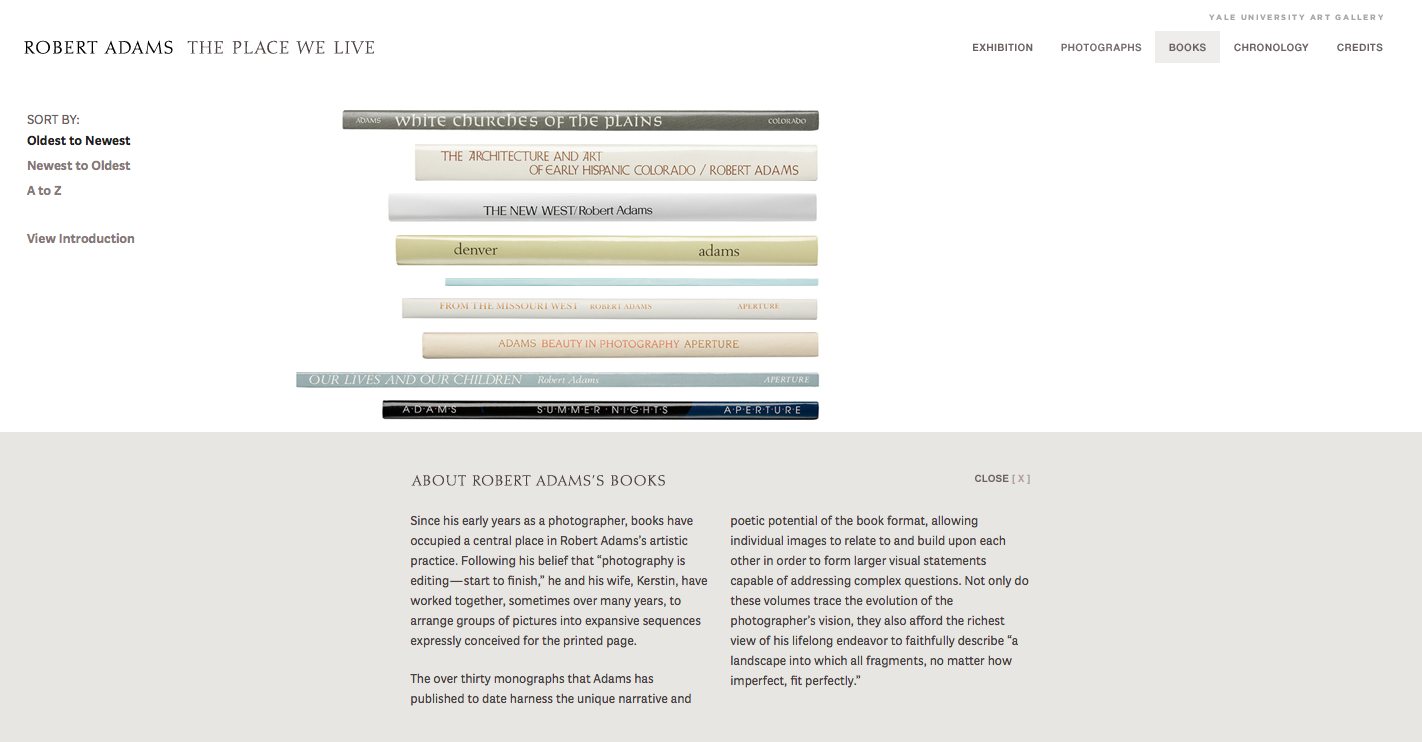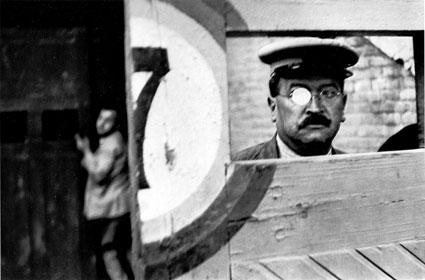For their Robert Adams exhibition, The Place We Live, the Yale University Art Gallery has built a positively brilliant micro-site to accompany the show. The wonderfully simple site lets you explore a selection of images from all of the series included in the show. The best feature of the site is the virtual bookshelf (pictured in the screenshot above) which includes all of Adams books. By clicking on the spines, you access more info about the book and some sample spreads. Not only that but the book content is linked to the related prints that will be exhibited in the show... I haven't been this excited by a photography website in a long time. In addition to presenting over 300 of Adam's prints, the exhibition is a total bookfest as the gallery is publishing a heavyweight ($250) three-volume retrospective hardcover catalogue and a more affordable ($25) paperback What We Can Believe Where?: Photographs of the American West. On top of this the Gallery is revising and reissuing three Adams classics, denver, What We Bought, and Summer Nights and, if that isn't enough Adams for you, they will also be publishing Sea Stories and This Day, a pair of books featuring pictures made in Oregon over the past ten years. Sadly, I'm unlikely to be able to see this show, but, with a site as good as this one, this feels a lot less like a disappointment.
Review: Henri Cartier-Bresson @ MAM
HCB would have been 100 in 2008. For some reason his centenary is still being celebrated with two exhibitions which recently opened in Paris at the Maison Européene de la Photographie and today at the Musée d'Art Moderne (MAM). I was reminded of the Robert Frank exhibitions that were recently held in honour of the 50th anniversary of his seminal book, The Americans. I didn't see the exhibition at the NGA in Washington, Looking In, but judging by the catalogue this was a really impressive show in which the curators used this anniversary to take a fresh look at Frank's work for this series, uncovering new material and contributing a meaningful new perspective on the place of that series in photographic history. The exhibition that I saw at the Jeu de Paume was the polar opposite: it was essentially the book hung, in order, on the wall. There seemed to be no attempt to use this opportunity to do something different with the series, to uncover new details, present it in a new light, even develop a new scenography. As I walked around on the opening weekend with the hundreds of other people, waiting 2 or 3 minutes to see each image, this felt very much like an attempt to get as many people through the door with as little effort as possible.
Unfortunately, the current Cartier-Bresson mini-retrospective at the MAM, L'imaginaire d'après nature, falls into the latter category. The exhibition contains 69 large-format prints made in the 1970s, and donated to the museum in 1982 following two exhibitions of his photographs and drawings. This exhibition brings these donated prints out of storage after 27 years and I was curious to see what they would add to our understanding of HCB. Apparently one of the reasons why this is not "just another HCB exhibition" is that this is a unique opportunity to see appreciate his prints in a large format (they are around 50 x 70 cm, dry-mounted on board and unframed), and to "interact with the print as object", not just to appreciate the quality of his imagery in a small format behind a pane of glass. However, HCB didn't make the prints himself and I find that the images are not suited to these large formats. So maybe the value of the exhibition is in the choice of images, perhaps focusing on some lesser-known aspect of his work? The genius of HCB is indisputable, and many of these images still manage to retain their impact despite being so well-known, but while there are a handful of rarities, 95% of what is on show here has been seen everywhere and by everyone.
Seeing this exhibition at a National Museum of Modern Art in 1982 would have been a revelation and a bold statement on the place of photography within art. Seeing it today, it feels precisely like "just another Cartier-Bresson exhibition", and one which is attempting to cash in cheaply on an anniversary.
Rating: Worth looking elsewhere
Taisuke Koyama
 During my exceedingly short trip to Tokyo earlier this month, a friend of mine took me on a whirlwind up-and-coming-photography tour of Tokyo. First stop was at the G/P Gallery, in the new NADiff a/p/a/r/t art complex in Ebisu (which incidentally has an excellent art bookstore). They had a small solo-show (14 prints) of the young photographer Taisuke Koyama's entropix series. I had made a mention of Koyama's work in the piece I wrote for Images magazine last year highlighting some of the Japanese photography on show at the 2008 edition of Paris Photo. I didn't get to see enough of his prints at the fair, but I found the couple of images that I did see interesting.
During my exceedingly short trip to Tokyo earlier this month, a friend of mine took me on a whirlwind up-and-coming-photography tour of Tokyo. First stop was at the G/P Gallery, in the new NADiff a/p/a/r/t art complex in Ebisu (which incidentally has an excellent art bookstore). They had a small solo-show (14 prints) of the young photographer Taisuke Koyama's entropix series. I had made a mention of Koyama's work in the piece I wrote for Images magazine last year highlighting some of the Japanese photography on show at the 2008 edition of Paris Photo. I didn't get to see enough of his prints at the fair, but I found the couple of images that I did see interesting.
Entropix is a series of visual fragments, seemingly haphazard abstractions that still retain a link to their subject (paint peeling, pink fabric, tarmac, sheet metal). The images are highly detailed, feeling like microscopic, molecular studies of the surfaces of the city. Koyama's compositions are both strong and simple, and they retain an instinctive energy reminiscent of Eggleston's shotgun approach. The (digital) prints are good, although I prefer the smaller prints to the larger edition (1.2 x 1.8m), which I found diluted the impact of the images a bit.
I ran into Koyama later on that evening at a discussion organised by Akira Rachi at CAMP in Hacchobori (more on this later) where he was presenting entropix and had a chance to chat briefly to him. He will be coming to Paris Photo with G/P again this year so this will be a chance to see more of his work. And if you don't feel like waiting until then, a catalogue of the series is also available from G/P. One to watch.
Japan: A Self-Portrait opening in Tokyo
 I have been a bit quiet over the past few days as I have been busy working on two exhibition projects. Last week I went to Sweden to meet with a museum who will be holding the exhibition, Tokyo Stories, which I curated last year and was shown during Paris Photo 2008 at Artcurial. The details still need to be confirmed, but I'll be posting on this again soon I'm sure.
I have been a bit quiet over the past few days as I have been busy working on two exhibition projects. Last week I went to Sweden to meet with a museum who will be holding the exhibition, Tokyo Stories, which I curated last year and was shown during Paris Photo 2008 at Artcurial. The details still need to be confirmed, but I'll be posting on this again soon I'm sure.
The exhibition that has been keeping me really busy these past few weeks (going on years) is Japan: A Self-Portrait, based on my first major project in the field of Japanese photography, the book published by Flammarion in 2004. The exhibition brings together work by the leading photographers of the postwar years, a time of radical and disruptive change for Japan and to my mind one of the richest photographic periods in the country's history. The photographers included in the show are: Ken Domon, Hiroshi Hamaya, Tadahiko Hayashi, Eikoh Hosoe, Yasuhiro Ishimoto, Kikuji Kawada, Ihee Kimura, Shigeichi Nagano, Ikko Narahara, Takeyoshi Tanuma and Shomei Tomatsu. You can find out more on the show on the Studio Equis website or on the excellent Tokyo Art Beat. The exhibition opens at the Setagaya Art Museum from 2 May to 21 June and will then travel to other venues in Japan. I hope that some of you will get a chance to see it.
Update: I just did an interview with the blog on Japanese photography, Japan Exposures.
Forward Thinking Museum
I recently discovered the JGS Forward Thinking Museum, an online virtual museum that is run by the not-for-profit, Joy of Giving Something. It is a pretty quirky experience, complete with the voice of a guy selling hot dogs on the street corner, robots in wheelchairs, abseiling window-cleaners, laid off bankers trying to hitch a ride home and much more. The navigation is a little clunky because of all these elements, but the depth of material on show makes it worth an extended visit. I think that JGS is involved with Nazraeli Press as a lot of the artists that they have published can be found in the museum. The thing I enjoyed most was the 'permanent exhibitions' on show here. Japanese photography is often absent from the internet, and I was delighted to find a great selection of work here by some of the more interesting contemporary Japanese artists including Naoya Hatakeyama, Eiji Ina, Yuki Onodera, Toshio Shibata, Risaku Suzuki and Masao Yamamoto. As an added bonus, there is a section of the museum called FTM Theater with a selection of short films on the artists at work. I will be a regular visitor.


